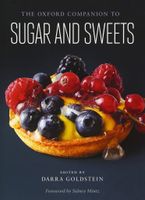Sweets in Regional Cultures
Published 2015
In the seventeenth century, the custom of selling cakes, sweets, and biscuits on the streets emerged in Brazil’s northeastern and midwestern regions, the hubs of the colonial agricultural empire. A set of goodies was often laid out in trays and dubbed quitanda, or grocery—a name that is still used to designate this manner of selling candy and sweet snacks today in these parts of the country.
In the northeast of Brazil, coconut and sugar are commonly combined to make coconut sweets of various kinds: creamed coconut, coconut ribbon, white coconut, burnt coconut, or coconut mixed with cassava or cassava meal for making cakes, puddings, porridges, and beijus (crepe-like wafers) of tapioca (a derivative of cassava). See tapioca. In the midwest, most sweets are made from fruit, which is also candied and made into jams and preserves. Corn, milk, eggs, and fresh cheese also find their way into desserts there. In the south, with its colder climate, wheat-based sweets introduced from Italy and Germany dominate, including apple tarts, grape cakes, and fried or baked cookies.
Become a Premium Member to access this page
Unlimited, ad-free access to hundreds of the world’s best cookbooks
Over 160,000 recipes with thousands more added every month
Recommended by leading chefs and food writers
Powerful search filters to match your tastes
Create collections and add reviews or private notes to any recipe
Swipe to browse each cookbook from cover-to-cover
Manage your subscription via the My Membership page
Part of
Advertisement
Related Recipes
-
-
-
-
Related Reference
-
-
-
-
Advertisement



